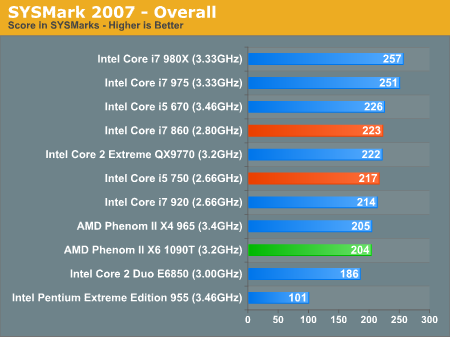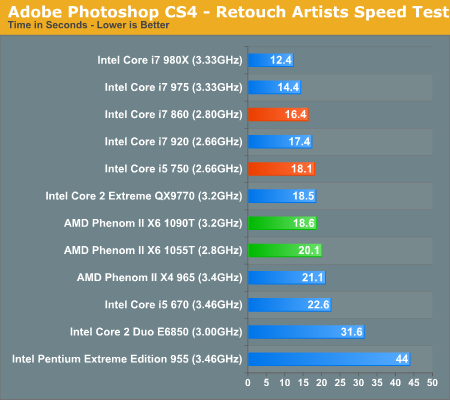AMD's Six-Core Phenom II X6 1090T & 1055T Reviewed
by Anand Lal Shimpi on April 27, 2010 12:26 AM EST- Posted in
- CPUs
- AMD
- Phenom II X6
SYSMark 2007 Performance
Our journey starts with SYSMark 2007, the only all-encompassing performance suite in our review today. The idea here is simple: one benchmark to indicate the overall performance of your machine.
SYSMark really taxes two cores most of the time, giving the edge to Lynnfield and its aggressive turbo modes. Lightly threaded or mixed workloads won't do so well on the Phenom II X6.

Adobe Photoshop CS4 Performance
To measure performance under Photoshop CS4 we turn to the Retouch Artists’ Speed Test. The test does basic photo editing; there are a couple of color space conversions, many layer creations, color curve adjustment, image and canvas size adjustment, unsharp mask, and finally a gaussian blur performed on the entire image.
The whole process is timed and thanks to the use of Intel's X25-M SSD as our test bed hard drive, performance is far more predictable than back when we used to test on mechanical disks.
Time is reported in seconds and the lower numbers mean better performance. The test is multithreaded and can hit all four cores in a quad-core machine.

Performance here is good, but even Photoshop doesn't make consistent enough use of all six cores to really give the Phenom II X6 the edge it needs here. It's faster than the Phenom II X4, but not faster than the Core i5 750.










168 Comments
View All Comments
kwm - Wednesday, April 28, 2010 - link
did the big bad caps scare you. sorryTaft12 - Tuesday, April 27, 2010 - link
OF COURSE 6 CPU CORES WILL PROVIDE A TANGIBLE BENEFIT TO VIRTUALIZED PLATFORMS!Skiprudder - Tuesday, April 27, 2010 - link
To folks asking for a more detailed overclocking review, I would just say that Anand almost always releases an in-depth OC article on a new CPU architecture anywhere from a day to a week later. I think he usually wants to get the basic info out first, then delve into the nitty gritty for those who OC.silverblue - Tuesday, April 27, 2010 - link
I think Thuban could've been a little better realised;1) Higher uncore speed - whatever happened to the touted 5.2GT/s HT3 link?
2) Triple channel controller - AMD have been using dual channel controllers for the best part of a decade - this HAS to be starving Thuban
3) Keeping the Phenom II's core control system. Phenom I may have been more elegant, but even if Thuban is faster at ramping up the voltages, it'll still result in issues with XP and Vista. So, the targetted audience, at least for Microsoft users, would be Windows 7.
Which reminds me... SysMark is on Vista, an OS known to cause issues with Phenoms. Would this have detrimentally affected the X6's scores, even if two cores are being taxed?
I don't think extra cache would be viable for AMD. The Athlon II X4s aren't far behind equivalent clocked Phenom II X4s even without any L3 cache, plus the added expense and die complexity would've just pushed prices, and temperatures, upwards. Of course, a higher model with 8MB of L3 cache would be nice to see.
It's not really a disappointment to see Thuban fail to topple the entry-level Nehalems. Remember that they're logical 8-thread CPUs and are thus more efficient at keeping their pipelines fed. You can still get a high-end AMD setup for cheaper than the competing Intel setups; just throw some heavily threaded software at it and it'll do very nicely. The new X4s may just give Intel cause to drop prices though.
One final thing - AMD's offerings are known to perform far closer to Intel CPUs when every single bit of eye candy is enabled in games, including AA, and pushing the resolution upwards. It may have been more telling had this been done.
silverblue - Tuesday, April 27, 2010 - link
Ignore the last bit; it wouldn't be a good indication of the power of Thuban.gruffi - Wednesday, April 28, 2010 - link
1) Higher uncore speed means higher power consumption and probably less power efficiency.2) You would need a new platform that makes the current one obsolete. You would also need much more time and money to validate.
3) I actually see no problem.
Sry, but your claims are unrealistic or pointless.
silverblue - Thursday, April 29, 2010 - link
"1) Higher uncore speed means higher power consumption and probably less power efficiency."You could just reduce the clock speeds to compensate, assuming a higher uncore yields a satisfactory performance increase. The i7-920 has an uncore speed of 2.13GHz and Phenom IIs at 2GHz.
"2) You would need a new platform that makes the current one obsolete. You would also need much more time and money to validate."
Fair dos.
"3) I actually see no problem."
The potential for a thread hitting an idle core would still be there as, even with Turbo CORE doing its thing, there would be the potential for three idle cores, however this will be minimised if AMD has decreased the delay needed for a core to ramp back up from 800MHz.
"Sry, but your claims are unrealistic or pointless."
That's fine.
jonup - Tuesday, April 27, 2010 - link
Nice read; well done Anand! Are you planning to do an OC follow up like you,ve done in the past. Also I noticed that on the second "CPU Specification Comparison" chart on the first page "AMD Phenom II X4 965" is included twice.p.s. What's IOMMU? Can someone explain please?
Ryan Smith - Tuesday, April 27, 2010 - link
The short answer is that an IOMMU is a memory mapping unit (MMU) for I/O devices (video cards, network controllers, etc). For most readers of this site, the only time they'd use an IOMMU is when using a virtual machine, as an IOMMU allows the virtualize OS to talk more or less directly to the hardware by translating the virtual addresses to the physical addresses the hardware is using. However it does have other uses.jonup - Tuesday, April 27, 2010 - link
Thanks!